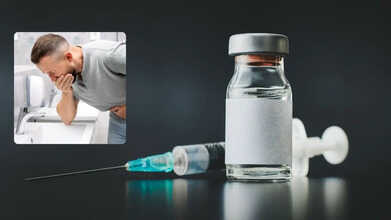- Health Conditions A-Z
- Health & Wellness
- Nutrition
- Fitness
- Health News
- Ayurveda
- Videos
- Medicine A-Z
- Parenting
Experts Are Split On Whether The Internet Access Is Bad For Mental Health And Here's Why

It is a challenging and uncertain time for discourse about the internet. On the one hand, recent developments like artificial intelligence have led to a kind of aversion to digital screen time, especially since we now know just how much of the internet and social media algorithms are artificially fuelled by emotions like hate and anger. On the other hand, recent cases seem to suggest that taking away this technology isn’t leading to any benefits either.
As a parent, many eyes are on Jonathan Haidt. The author of ‘The Anxious Generation’ is currently the leading voice advocating for more awareness of the effects of smartphone technology amongst children and teens. However, as many US states move to actually enforce these bans, the science is actually showing that we aren’t seeing the mental health benefits that we are expecting.
What Is The Central DIlemma Behind This Split?
Firstly, the context behind these experts’ opinions is important to consider. Several schools in the US are starting to enforce a ban on smartphones on the campus grounds. The main reasons cited behind why is a substantive body of data from the past decade that shows that mental illnesses like depression and anxiety have been shooting up around the same time that smartphone usage became widely accepted.
Jonathan Haidt was one of the first to point out this correlation in his book, as mentioned before, however, psychological experts are still unsure if smart phones are to blame.
Dr, Michael Rich, the founder behind the Digital Wellness Lab, has pointed out that Haidt and many of those who agree with him are ignoring the positives of the Internet to push a narrative. Children are learning to connect with people over greater distances and to understand a greater variety of cultures beyond their own.
The Effect of Smart Phones in Schools
However, the biggest point of contention is the association between age and mental illness. Smartphone bans on campuses so far have shown fantastic results in terms of disciplining children. There’s less disruption in classrooms and students are able to focus on their assignments better.
However, there’s no visible difference in how it affects their mental health. Smartphones may potentially be accelerating symptoms, however, what it shows is that there are a lot of other environmental factors contributing to the rise in anxiety and depression.
Adenovirus: Highly Contagious Mystery Illness Spreading Fast, Watch Out for These 12 Symptoms

Credits: Canva
The so-called “mystery virus” behind lingering sore throats, blocked noses filled with mucus, and days of exhaustion is actually well known to doctors. According to Eric Sachinwalla, medical director of infection prevention and control at Jefferson Health, the culprit is adenovirus.
What makes this virus particularly difficult to control is how tough it is. Adenovirus can survive soap and water, withstand many everyday disinfectants, and linger on contaminated surfaces for long stretches of time. Below is what experts know so far about this fast-spreading infection.
What Is Adenovirus?
Adenovirus refers to a group of common viruses that usually trigger cold- or flu-like illness. It spreads easily because it is far more resilient than many other viruses. Ordinary soap, water, and standard disinfectants do not reliably destroy it, allowing it to persist in the environment. As a result, infections often cluster in places where people spend time close together, such as daycares and military barracks. The virus spreads through the respiratory tract, can be shed in stool, and can survive for some time on contaminated surfaces, according to the CDC.
Adenovirus: What Are The Symptoms Of Adenovirus?
“Adenovirus is a typical virus that causes common cold or flu-like symptoms,” says Dr Deborah Lee at Dr Fox Online Pharmacy. That does not mean adenovirus is the same as a cold. Instead, adenovirus is one of many germs that can cause cold-like illness. A simple way to think about it is that a “cold” describes the symptoms, while adenovirus is one specific virus that can lead to them.
Symptoms can vary depending on the subtype involved. While there are more than 100 known subtypes, only 49 infect humans. Dr Lee notes that people may experience any of the following:
- Fever
- Runny nose
- Sore throat
- Swollen cervical lymph nodes in the neck
- Cough
- Shortness of breath
- Conjunctivitis
- Ear pain
- Diarrhoea
- Vomiting
- Stomach pain
- Urinary tract infection
Adenovirus? Is It Contagious?
“Adenovirus infection is highly contagious,” Dr Lee explains. “It spreads by breathing in infected droplets, by touching the virus and then rubbing the eyes, or through the faecal-oral route, often due to poor hand hygiene after using the toilet.”
She adds that the virus spreads quickly in crowded settings where people are in close contact. To eliminate adenovirus from surfaces, Dr Lee recommends stronger cleaning agents such as bleach-based solutions or hydrogen peroxide. “The virus is resistant to soap and many commonly used cleaners,” she says.
To reduce the risk of catching adenovirus or other respiratory infections currently circulating, Dr Lee advises staying away from people who are unwell. She also suggests the following precautions:
- Avoid touching your face and nose
- Use a clean tissue to blow your nose and dispose of it immediately
- Wash your hands often with soap and warm water, then dry them thoroughly, especially after using the toilet or changing nappies
- Clean children’s toys regularly
- Disinfect worktops, changing areas, toilets, and bathrooms
- Avoid sharing cups, plates, food, or towels
- Wear a mask if you need to go out while unwell
- Keep windows open and ensure rooms and workspaces are well ventilated.
Top 5 Health Crises That Impacted the World in 2025

Credits: iStock
As we soon step into 2026, it is time to look back at which diseases took over the world in 2025. These diseases evolved throughout the year, and led to complex challenges. Here, we explore the top 5 health crisis in 2025.
Infectious Diseases, Outbreaks, and COVID-19
This year, COVID-19 continued to make headlines, along with COVID, flu and measles too continued to infect people. In fact, new variants of COVID and flu have circulated across the world, leading to new kinds of symptoms, including razor-blade like throats in COVID-19. Influenza too surged up across US, UK, and Canada, with hospitalization rates going up. A new subclade K strain is seen responsible for this surge. Measles, too is a highly contagious, however, vaccine-preventable respiratory virus resurged this year, and this disease, which was once eliminated from the US, has come back due to lower rates of vaccination.
Tuberculosis Outbreak
A tuberculosis outbreak in the Kansas City metro area resulted in dozens of cases. This has led to two deaths, as reported by the Kansas Department of Health and Environment (KDHE). In fact, Michael A Bernstein, MD, director of pulmonary and critical care at Stamford Health said that many people assume that TB is rare and no longer a concern, however, it still remains common.
Also Read: Top 5 Infectious Diseases That Disrupted Healthcare System Worldwide In 2025
Bird Flu
In the US, the first death from bird flu was reported by the Louisiana Department of Health. The Centers for Disease Control and Prevention (CDC) reported that the individual was older than 65 years and had underlying medical conditions. That person developed severe illness and was hospitalized following the exposure to a noncommercial backyard flock and wild word. In fact, new studies have shown that bird flu viruses could have a potential risk for humans and may become next pandemic. This comes from two different studies, one done by the universities of Cambridge and Glasgow that show how avian flu strains are multiplying even when the body temperatures could hinder viruses. Whereas, another important study led by Indian scientists, by Philip Cherian and Gautam Menon of Ashoka University, published in BMC Public Health predict if H5N1 or the bird flu virus, could start spreading among humans.
Antimicrobial Resistance (AMR)
In 2025, AMR has worsened and the resistance has risen over 40% of monitored pathogen-antibiotic pairs between 2018-2023. Due to the resistance, common infections become harder to treat, especially in regions like Southeast Asia, with India facing high rates. The World Health Organization (WHO) report notes that AMR is a growing threat to global health, and draws on more than 23 million bacteriologically confirmed cases of bloodstream infections, urinary tract infections, gastrointestinal infections, and urogenital gonorrhoea.
Non Communicable Diseases or NCDs
NCDs like heart disease, cancer, diabetes, and respiratory illnesses remained a persistent global health challenge in 2025. Trends to showed a continued rise driven by unhealthy lifestyles, which included processed food, inactivity, tobacco or alcohol, and urbanization.
Norovirus 2025: Is There A Vaccine For The Stomach Bug Spreading This Year?

Credits: Canva
Dozens of norovirus outbreaks have been recorded nationwide over the past few weeks, and as people deal with intense vomiting, diarrhea, and other uncomfortable or even risky symptoms, a common question keeps coming up: why is there still no vaccine for such a widespread infection.
The Centers for Disease Control and Prevention (CDC) says norovirus cases are increasing toward the end of 2025, with higher activity reported in both the US and the UK. Health officials note that a new, highly infectious strain known as GII.17 is partly driving this rise. Because many people have little or no immunity to it, outbreaks are being seen more often in schools and shared public spaces. While overall case numbers remain within typical seasonal ranges, recent weeks have shown a clear upward trend.
What Is Norovirus?
Norovirus is an extremely contagious virus that leads to gastroenteritis. It commonly causes symptoms such as vomiting, diarrhea, nausea, and stomach cramps, and may also bring fever and body aches. It is often referred to as the ‘stomach flu,’ though it has no connection to influenza.
The virus spreads quickly through contaminated food or water, shared surfaces, or direct contact with an infected person’s vomit or stool. Crowded settings like cruise ships are especially vulnerable. Most people recover within one to three days with rest and enough fluids, according to the CDC.
Norovirus Symptoms 2025
Norovirus usually comes on suddenly, causing vomiting, watery diarrhea, nausea, and abdominal pain. Fever, headaches, and body aches are also common. Symptoms typically appear 12 to 48 hours after exposure and last for one to three days. Because it spreads so easily, infections can move fast through families and communities.
While most cases improve on their own, dehydration is a concern, so warning signs such as intense thirst or reduced urination should not be ignored, as noted by the Cleveland Clinic.
Do We Have A Norovirus Vaccine?
At present, there is no widely available vaccine for norovirus. That said, research has made meaningful strides. Experimental oral vaccines have shown encouraging results in clinical studies, suggesting they may offer protection against multiple fast-changing strains and help reduce how much virus an infected person sheds. Scientists are hopeful that an effective, broadly protective vaccine may become available in the coming years, according to the National Institutes of Health.
Why Don’t We Have a Norovirus Vaccine Yet?
Developing a vaccine for norovirus has proven especially difficult, largely because of how quickly the virus changes. “It really is evolving extremely rapidly, and that’s a big problem,” Patricia Foster, PhD, professor emerita of biology at Indiana University Bloomington, told Health.
Norovirus also exists in dozens of subtypes, with several dominant strains circulating at any given time. This is why people can catch norovirus more than once in their lives. Even if immunity develops against one strain, either after infection or through vaccination, another strain can still cause illness. Centers for Disease Control and Prevention. About norovirus.
Norovirus: Multiple Vaccines Are In The Works
Despite these obstacles, vaccine research is moving forward. Progress has accelerated in part because of newer technologies developed over the past decade. In 2016, Mary Estes, PhD, a researcher at Baylor College of Medicine, and her team found a way to grow norovirus outside the human body. This breakthrough made it possible to test vaccine approaches and treatments more effectively. This step was crucial because common lab animals like mice do not typically get sick from human norovirus.
Today, scientists are testing several experimental vaccines. One example is a 2023 vaccine developed at Washington University School of Medicine in St. Louis that combines protection against norovirus with an existing rotavirus vaccine. Several pharmaceutical companies are also developing candidates, many of which are now in clinical trials, said Amesh Adalja, MD, senior scholar at the Johns Hopkins Center for Health Security, in comments to *Health*.
HilleVax, a Boston-based company, has been testing a norovirus vaccine originally developed by Japan’s Takeda. However, that candidate did not succeed in a phase II trial in June 2024. Meanwhile, a tablet-style norovirus vaccine from San Francisco-based Vaxart has completed phase I testing. Among the most promising efforts is Moderna’s vaccine, which is currently being tested in human volunteers.
Preventing Norovirus, Even Without a Vaccine
Norovirus spreads so easily that stopping it once someone falls ill can be very challenging. This is linked to the virus’s structure. Norovirus is a nonenveloped virus, similar to polio and other stomach-related infections. Because of this, neither hand sanitizers nor soap and water actually destroy the virus, Foster explained. “Handwashing helps because you’re physically rinsing the virus away,” she said.
As a result, basic hygiene practices, especially thorough handwashing, remain some of the most effective ways to lower risk, said Ming Tan, PhD, an infectious disease researcher and associate professor of pediatrics at Cincinnati Children’s Hospital Medical Center, speaking to *Health*.
If norovirus does strike, treatment options are limited. Staying hydrated is essential to avoid complications from fluid loss. Some people may also use medicines to control nausea or diarrhea, either over the counter or by prescription, such as Zofran. If severe symptoms develop, including confusion, high fever, or intense abdominal pain, medical care should be sought right away.
© 2024 Bennett, Coleman & Company Limited

